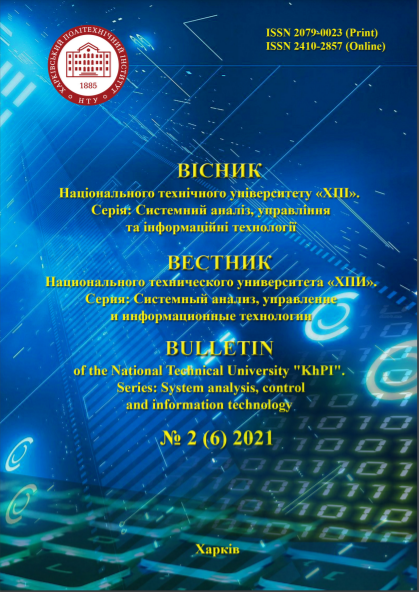THE USE OF MACHINE LEARNING METHODS FOR BINARY CLASSIFICATION OF THE WORKING CONDITION OF BEARINGS USING THE SIGNALS OF VIBRATION ACCELERATION
DOI:
https://doi.org/10.20998/2079-0023.2021.02.03Keywords:
machine learning, vibration diagnostics of rolling bearing defects, data processing, signal feature mining, fast Fourier transform, classification of unbalanced datasets, Monte Carlo method, bootstrapAbstract
The paper investigates the relationship between vibration acceleration of bearings with their operational state. To determine these dependencies, a test
bench was built and 112 experiments were carried out with different bearings: 100 bearings that developed an internal defect during operation and 12
bearings without a defect. From the obtained records, a dataset was formed, which was used to build classifiers. Dataset is freely available. A method
for classifying new and used bearings was proposed, which consists in searching for dependencies and regularities of the signal using descriptive functions: statistical, entropy, fractal dimensions and others. In addition to processing the signal itself, the frequency domain of the bearing operation
signal was also used to complement the feature space. The paper considered the possibility of generalizing the classification for its application on those
signals that were not obtained in the course of laboratory experiments. An extraneous dataset was found in the public domain. This dataset was used to
determine how accurate a classifier was when it was trained and tested on significantly different signals. Training and validation were carried out using
the bootstrapping method to eradicate the effect of randomness, given the small amount of training data available. To estimate the quality of the
classifiers, the F1-measure was used as the main metric due to the imbalance of the data sets. The following supervised machine learning methods
were chosen as classifier models: logistic regression, support vector machine, random forest, and K nearest neighbors. The results are presented in the
form of plots of density distribution and diagrams.
References
Nguyen P., Kang M., Kim J., Ahn B., Ha J., Choi B. Robust condition monitoring of rolling element bearings using de-noising and envelope analysis with signal decomposition techniques. Expert systems with applications. 2015, vol. 42, no. 22, pp. 9024–9032. doi: 10.1016/j.eswa.2015.07.064.
Graney B., Starry K. Rolling element bearing analysis. Engineering. Materials evaluation. 2012, vol. 70, pp. 78–85.
Naumenko A. P., Kudryavtseva Y. S. Dyahnostyrovanye defektov y neyspravnostey mashyn y mekhanyzmov: ukazanyya k laboratornim rabotam. [Diagnosis of defects and malfunctions of machines and mechanisms: instructions for laboratory work]. Omsk: OmHTU Publ., 2017. 60 p.
Tadzhibaev A. I., Draganchev H., Yarovoy V. S., Gayurov L., Korkin L. M., Forecasting of the technical condition of rolling bearings based on vibration analysis. Materials Science. Power Engineering. 2021, pp. 77–85, doi: 10.18721/JEST.27307.
Akutin M. V. Method of monitoring the state of rolling bearings based on the comparison of wavelet scalegrams. Izvestiya vuzov. Energy problems. 2009, no. 1–2, pp. 145–149. URL: https://cyberleninka.ru/article/n/metod-kontrolya-sostoyaniyapodshipnikov-kacheniya-na-osnove-sravneniya-veyvletskeylogramm (date accessed 07.12.2021).
Kan Sh. Ch., Mykulovych A. V., Mykulovych V. Y. Spektral'niy analyz ohybayushchey visokochastotnikh sostavlyayushchykh slozhnikh syhnalov na osnove empyrycheskoy dekompozytsyy mod y preobrazovanyya Hyl'berta. [Spectral analysis of the envelope of high-frequency components of complex signals based on empirical mode decomposition and Hilbert transform]. Informatyka. 2010, vol. 4, no. 28, pp. 16–26.
Soto-Ocampo R., Cano-Moreno J., Mera J., Maroto J. Bearing severity fault evaluation using contour maps-case study. Applied sciences. 2021, vol. 11, no. 14, pp. 2–30. doi: 10.3390/app11146452.
Cococcioni M., Forte P., Sacchi C., Manconi S. A machine learning approach to fault diagnosis of rolling bearings. 2008 IEEE international conference on computational cybernetics (ICCC), Stara Lesna, Slovakia, 27–29 November 2008. 2008, pp. 209–214. doi: 10.1109/icccyb.2008.4721407.
Nishizaki H., Makino K. Signal classification using deep learning. 2019 IEEE international conference on sensors and nanotechnology (SENSORS & NANO), Penang, Malaysia, 24–25 July 2019. 2019, pp. 1–4. doi: 10.1109/sensorsnano44414.2019.8940077.
Soto-Ocampo C., Cano-Moreno J., Mera J., Maroto J. Bearing Database. Available at: https://zenodo.org/record/3898942#.YbZtrr1ByUm (accessed 01.12.2021).
Isaienkov K. Bearing classification. Available at: https://www.kaggle.com/isaienkov/bearing-classification (accessed 22.09.2021).
Pedregosa F., Scikit-learn: Machine Learning in Python. Journal of Machine Learning Research. 2011, vol. 12, pp. 2825–2830.
Babudzhan, R., Isaienkov, K., Krasii, D., Melkonian, R., Vodka, O., Zadorozhniy, I., & Yushchuk, M. Collection and processing of bearing vibration data for their technical condition classification by machine learning methods. Modeling Control and Information Technologies. 2021, vol. 5, pp. 10–15. doi: 10.31713/mcit.2021.02.
Müller A., Guido S. Introduction to Machine Learning with Python: A Guide for Data Scientists. O’Reilly Media, 2016. 400 p.
Sulaiman M., Hossin M. A Review on Evaluation Metrics for Data Classification Evaluations. International Journal of Data Mining & Knowledge Management Process. Vol. 5, pp. 1–11. doi: 10.5121/ijdkp.2015.5201.
Janitza S., Hornung R. On the overestimation of random forest’s out-of-bag error. PLoS ONE. 2018, vol. 13, pp. 2–19. doi: 10.1371/journal.pone.0201904.
Bruce P. and Bruce A. Practical Statistics for Data Scientists: 50 Essential Concepts. O’Reilly Media, 2017. 318 p.
Fishman G. Monte Carlo: concepts, algorithms, and applications. Springer, 1996. 689 p.
Downloads
Published
How to Cite
Issue
Section
License
LicenseAuthors who publish with this journal agree to the following terms:
- Authors retain copyright and grant the journal right of first publication with the work simultaneously licensed under a Creative Commons Attribution License that allows others to share the work with an acknowledgement of the work's authorship and initial publication in this journal.
- Authors are able to enter into separate, additional contractual arrangements for the non-exclusive distribution of the journal's published version of the work (e.g., post it to an institutional repository or publish it in a book), with an acknowledgement of its initial publication in this journal.
- Authors are permitted and encouraged to post their work online (e.g., in institutional repositories or on their website) prior to and during the submission process, as it can lead to productive exchanges, as well as earlier and greater citation of published work (See The Effect of Open Access).


